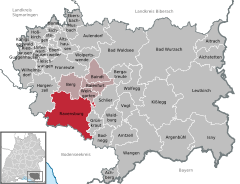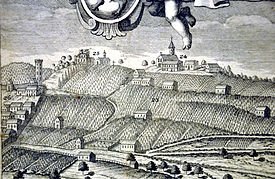You can help expand this article with text translated from the corresponding article in Alemannic. (October 2024) Click for important translation instructions.
|
| Ravensburg | |
|---|---|
| Town | |
 Ravensburg, seen from the west Ravensburg, seen from the west | |
 Flag Flag Coat of arms Coat of arms | |
Location of Ravensburg within Ravensburg district
 | |
  | |
| Coordinates: 47°46′59″N 9°36′41″E / 47.78306°N 9.61139°E / 47.78306; 9.61139 | |
| Country | Germany |
| State | Baden-Württemberg |
| District | Ravensburg |
| Municipal assoc. | Mittleres Schussental |
| Government | |
| • Lord mayor (2018–26) | Daniel Rapp (CDU) |
| Area | |
| • Total | 92.04 km (35.54 sq mi) |
| Elevation | 450 m (1,480 ft) |
| Population | |
| • Total | 51,482 |
| • Density | 560/km (1,400/sq mi) |
| Time zone | UTC+01:00 (CET) |
| • Summer (DST) | UTC+02:00 (CEST) |
| Postal codes | 88212–88214 |
| Dialling codes | 0751 |
| Vehicle registration | RV |
| Website | www.ravensburg.de |
Ravensburg (Swabian: Raveschburg) is a city in Upper Swabia in Southern Germany, capital of the district of Ravensburg, Baden-Württemberg.
Ravensburg was first mentioned in 1088. In the Middle Ages, it was an Imperial Free City and an important trading centre. The "Great Ravensburg Trading Society" (Große Ravensburger Handelsgesellschaft) owned shops and trading companies all over Europe.
The historic city centre is still very much intact, including three city gates and over 10 towers of the medieval fortification.
History
Ravensburg was first mentioned in writing in 1088. It was founded by the Welfs, a Frankish dynasty in Swabia who became later Dukes of Bavaria and Saxony and who made the castle of Ravensburg their ancestral seat.
By a contract of inheritance, in 1191 the Hohenstaufen Frederick Barbarossa acquired the ownership of Ravensburg from Welf VI, Duke of Spoleto and uncle of both Frederick Barbarossa and Henry the Lion.
With the death of Conradin 1268 in Naples the Hohenstaufen line became extinct. Their former estates became imperial property of the Holy Roman Empire. Like many other cities in Swabia, at the end of the 13th century Ravensburg became an Imperial Free City in 1276.

The "Great Ravensburg Trading Society" (Große Ravensburger Handelsgesellschaft) was founded at Ravensburg and Konstanz around 1380 by the merchant families of Humpis (from Ravensburg), Mötteli (from Buchhorn, modern-day Friedrichshafen) and Muntprat (from Constance). At first, the society mostly dealt in the production of linen and fustian. With the opening of one of the first paper mills north of the Alps in 1402 in Ravensburg, paper became another commodity. The Ravensburg stores also sold oriental spices, Mediterranean wines and Bohemian ores. After the liquidation of the Great Ravensburg Trading Society in 1530, Ravensburg stagnated economically. The Thirty Years' War caused a grave decline of the population. Swedish troops destroyed the old castle, now named "Veitsburg" after the St. Veit chapel at the castle grounds.
Following the Reformation a "paritetic" government emerged, meaning an equal distribution of public offices between the Catholic and Protestant confession. The city council was one half each Protestant and Catholic. For some time there was even a Catholic and a Protestant mayor at the same time, and both confessions celebrated the village fair, the "Rutenfest", apart from each other. This system was approved at the end of the Thirty Years' War in the Peace of Westphalia (1648) which named four "Paritetic Imperial Cities" (German: Paritätische Reichsstädte): Augsburg, Biberach, Dinkelsbühl and Ravensburg.
In 1803 the Immerwährende Reichstag passed the Reichsdeputationshauptschluss, a bill which included the secularisation and mediatisation of many German states — the first meaning the confiscation of the estates belonging to the church, the second the incorporation of the imperial estates and Imperial Free Cities into larger regional states. As a result, Ravensburg first became a Bavarian exclave within Württemberg. After a swap of estates between Bavaria and Württemberg it was incorporated in the Kingdom of Württemberg in 1810.
Since Ravensburg was impoverished and depopulated after the Thirty Years' War, only a few new buildings were raised during the 18th and the early 19th century. The benefit of this economic stagnation was the conservation of a widely intact medieval city with nearly all towers and gates of the historic fortification.
20th century
During World War II Ravensburg was strategically of no relevance. Ravensburg did not harbor any noteworthy arms industry (unlike nearby Friedrichshafen with its large aircraft industry), but was home to a major aid supplies center belonging to the Swiss Red Cross. The historic city centre was not damaged by air raids.
By 1945, the city came into the French occupation zone and thus came in 1947 to the newly founded state of Württemberg-Hohenzollern, which in 1952 merged to the state of Baden-Württemberg.
In the 1970s, Ravensburg increased in population and territory by the incorporation of smaller communities like Eschach, Schmalegg and Taldorf. Ravensburg University of Cooperative Education was established in the city in 1978.
In the 1980s, the Old Town was renovated and all transit traffic was banned from the city centre.

Economy and infrastructure
Ravensburg is a thriving shopping city in the wealthy region of Upper Swabia. Unemployment is relatively low. The nearest large cities are Munich, Stuttgart and Zürich, approximately a two-hour drive away each. Ulm, Konstanz and Bregenz are each less than a one-hour drive away.
Ravensburg is part of an urban agglomeration that also comprises Weingarten (Württemberg) and several suburbs. Ravensburg, Weingarten, and Friedrichshafen (on the shores of Lake Constance) share the functionality of a Oberzentrum (that is, the highest-ranked centre in the system of spatial planning and development in Baden-Württemberg).
Transport
Ravensburg is located at a crossing of the federal roads (national highways) B30, B31 and B32. A by-pass highway around Ravensburg and Weingarten was completed recently. The regional airport is situated at Friedrichshafen, about 15 km south of Ravensburg. The nearest national motor-ways are the A7 and A8 (approach at Ulm) and the A96 (approach at Lindau or Wangen im Allgäu).
In 1847, the railway station of Ravensbug was put in operation, part of the so-called "Swabian Railroad" from Stuttgart to Friedrichshafen, the oldest railroad of Württemberg and well known in all of Germany by the folk-style song Auf de Schwäb’sche Eisenbahne [de].
In 1888, the Ravensburg–Weingarten–Baienfurt tram line was open.
Local businesses
Mechanical engineering has traditionally been the main type of industry in the region. Based on the demand of the paper and textile industries (now widely reduced) and a long tradition of flour, paper and other mills, many engineering factories arose at the end of the 19th century. Today the primary engineering firms in Ravensburg are the left-overs of the former Escher-Wyss AG (a subsidiary of the Swiss Sulzer AG) which are now subsidiaries of the Austrian "Andritz Hydro".
Ravensburger AG, whose headquarters are located in the city, is a company internationally known for board games, jigsaw puzzles and children's books.
The pastry factory de:Tekrum (Theodor Krumm GmbH & Co. KG) is another company with an internationally known brand name. Since January 2005 it has been a wholly owned subsidiary of Griesson–de Beukelaer.
Other large industrial companies include:
- Vetter Pharma, a manufacturer of pre-filled injection systems
- Omira, one of the largest dairies in southern Germany
- the tool factory Hawera Probst (a subsidiary of Robert Bosch), the worldwide market leader in hammer drill bits
- the component supplier EBZ Engineering Bausch & Ziege (formerly Nothelfer, a subsidiary of ThyssenKrupp Automotive)
- the packaging manufacturer "Coveris Rigid" (formerly Autobar Packaging)
- two suppliers of solar power systems, Pro Solar Solarstrom and pro solar Energietechnik
Media
The local newspaper is the Schwäbische Zeitung.
The radio companies Radio 7 and Südwestrundfunk run broadcasting studios at Ravensburg. In Horgenzell near Ravensburg, the Ravensburg-Horgenzell transmitter transmitted Deutschlandfunk on the medium wave frequency 756 kHz.
Culture
The city's most popular festival is the annual "Rutenfest", which takes place mid year.
Sport
The city's association football club FV Ravensburg, formed in 1893, has played in the Oberliga Baden-Württemberg on three occasions from 1978 to 1983, from 1998 to 2000 and again since 2003.
From 2006 to 2010, Ravensburg hosted the Air Canada Cup or MLP Nations Cup, an international women's ice hockey tournament.
Twin towns – sister cities
See also: List of twin towns and sister cities in GermanyRavensburg is twinned with:
 Brest, Belarus
Brest, Belarus Coswig, Germany
Coswig, Germany Mollet del Vallès, Spain
Mollet del Vallès, Spain Montélimar, France
Montélimar, France Rivoli, Italy
Rivoli, Italy Aberdare, Wales, United Kingdom
Aberdare, Wales, United Kingdom Varaždin, Croatia
Varaždin, Croatia
Notable people


- Henry the Lion (1129/1131–1195), Duke of Saxony and Bavaria.
- Ladislaus Sunthaym (c. 1440 – c. 1512), historian and geographer
- Hans Buchner (1483–1538), organist and composer
- Joannes Susenbrotus (c. 1484 – c. 1542), humanist, taught in Ravensburg from 1522
- Franz Joachim Beich (1666–1748), painter
- Gustav Rümelin (1815–1889), statistician, pedagogue and author.
- August Natterer (1868–1933), art brut artist
- Karl Erb (1877–1958), tenor
- Elisabeth Gerdts-Rupp (1888–1972), jurist, lyric poet and ethnologist
- Klaus Schwab (born 1938), economist, founder of the World Economic Forum
- Theo Seiler (born 1949), ophthalmologist and physicist, pioneer of refractive surgery
- Andreas Gestrich (born 1952), historian and director of the German Historical Institute London
- Gregor Amann (born 1962), politician (SPD), Member of Bundestag 2005–2009
- Kai Diekmann (born 1964), journalist and former chief editor of the Bild-Zeitung
- Stefanie Dimmeler (born 1967), biologist and biochemist, Leibniz Prize winner
- Kofi Ansuhenne (born 1973), boy group singer ("Bed & Breakfast")
- Linus Roth (born 1977), classical violinist and academic teacher
- Wilhelm, Duke of Württemberg (born 1994), head of the House of Württemberg
Sport
- siblings Erich Buck, (born 1949) & Angelika Buck (born 1950), figure skaters
- Simon Henzler (born 1976), football player and coach, played 146 games
- Daniel Unger (born 1978), triathlete,
- Susanne Fellner (born 1985), ice hockey player
- Rahman Soyudogru (born 1989), footballer, played 198 games, mainly for FV Ravensburg
- Ömer Toprak (born 1989), Turkish footballer, played over 300 games and 27 for Turkey
- Emanuel Buchmann (born 1992), cyclist, comes from Vogt
- Anna-Maria Wagner (born 1996), judoka.
References
- Aktuelle Wahlergebnisse, Staatsanzeiger, accessed 14 September 2021.
- "Bevölkerung nach Nationalität und Geschlecht am 31. Dezember 2022" [Population by nationality and sex as of December 31, 2022] (CSV) (in German). Statistisches Landesamt Baden-Württemberg. June 2023.
- "Ravensburgs Partnerstädte". ravensburg.de (in German). Ravensburg. Retrieved 2021-03-14.
- "Henry "The Lion"" . Encyclopædia Britannica. Vol. 13 (11th ed.). 1911. pp. 294–295.
- "Rümelin, Gustav" . New International Encyclopedia. Vol. XVII. 1905.
External links
- Official website
 (in German)
(in German) - Rutenfest
- Blaserturm.de
| Towns and municipalities in Ravensburg (district) | ||
|---|---|---|
| ||



